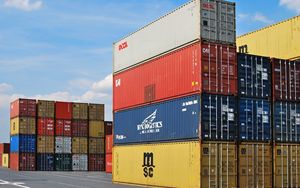(Finance) – 2022 marks a new record for Italy’s agri-food trade, both for imports, which reach the record value of almost 63 billion euros (+29.3%), and for exports, which after exceeded 50 billion in 2021, in the last year they are approaching the threshold of 60 billion euros (+16%). These dynamics are strongly influenced by the growth of international prices; however, increases in value are often accompanied by increases in volumes traded, although of a lesser intensity. Excellent performance for Made in Italy agri-food exports, with growth of 14.4% in 2022, higher than that recorded in the previous two years. This trend is mainly driven by processed products, such as pasta and tomato preserves. This is what emerges from 2022 report on foreign trade in agri-food products, now in its 31st edition, created by CREA Policies and Bioeconomy.
In 2022 the growth in Italian agri-food exports it is generalized and concerns almost all major markets and products. A few exceptions are made, such as apples, which are decreasing in both value (-2.1%) and quantity (-3.6%), and DOP red wines, for which increases in value hide contractions in exported volumes. Even on the import side, the increase, especially economic, affects many of the main products and is particularly marked for seed oil, raw coffee and corn. Purchases of fish products in volume, after the clear growth in 2021, have started to decline again in the last year, against an increase in value.
In general, for both imports and exports, clear increases often correspond to smaller increases, or even reductions, in quantities exchangedthanks to the general increase in average unit values.
Lexport of Made in Italy agri-food, that is to say, of those products recognized abroad as typical of our country, it will reach almost 43 billion euros in 2022, growing by over 14%. Excellent performance in sales of pasta (+38% in value) and canned tomatoes (+28%), after the setback of the previous year. The sales of other important Made in Italy products, such as olive oil and roasted coffee, also grew in value by over 20%. In 2022 lthe EU27 area concentrates 58% of Italy’s foreign sales and 68% of purchases, shares slightly decreasing compared to 2021. Despite Brexit, exports to the United Kingdom increased by over 13%. The effects of the conflict, however, determine a contraction of our flows towards Russia and Ukraine. The North America confirms itself as the first non-European destination market, thanks to the sales of many Made in Italy products, such as extra virgin olive oil and DOP sparkling wines, for which the United States is Italy’s first customer.
On the side of imports, is increasingly relevant role of Asia, with a 9% share of Italian agri-food imports. All the main import products from the Asian market have an impact, such as oils and fatty acids for the cosmetics industry, raw coffee and fish products.
The data for the first six months of 2023 highlight a further increase in trade in value, although lower than that found in 2022. The percentage growth of agri-food exports is in line with that of imports. In particular, exports in the first half of the year grew by 8.4%, exceeding the record value of 31 billion euros, while imports recorded a +8.9%, with a value of approximately 33 billion. In many cases, increases in the value of trade correspond to smaller increases or contractions in the quantities exchanged, such as, for example, for pasta exports (+6.7% in value and -6.4% in volume) or imports of processed fish (+6.6% in value and -4.1% in volume).
L’export in quantity of DOP red wines marks a contraction (-10%), only partially offset by the increase in prices. However, thanks to the greater exports of other types of wines, such as PGI whites or PDO sparkling wines, the wine sector remained overall stable in the first half of 2023. Roasted coffee exports are growing (+13.4% in value and +3.5% in quantity), confirming the excellent performance of 2022.
The trend of the imports of sunflower oil: after the sharp increase last year also linked to the surge in prices, in the first months of 2023 there was a strong contraction in the value of purchases (-25%), accompanied by a much smaller drop in quantities (-2.3% ). The reduction in the international price of this product, after the peak reached in 2022, has an impact.
“These numbers demonstrate that the world is hungry and thirsty for Italy. Because our nation is synonymous with quality – commented the Minister of Agriculture, Food Sovereignty and Forestry, Francesco Lollobrigida –. We work to defend, protect and enhance our agri-food excellence that generates wealth. This is why we have nominated Italian cuisine for UNESCO heritage, to describe a system of values, flavors and traditions, and we fight the fake market which takes billions of euros away from our economy. In the European context, however, we have firmly opposed cases of evocation of Italian Geographical Indications, such as in the case of Slovenian balsamic vinegar and Croatian prosek. Because defending our primary asset means defending Italy.”
